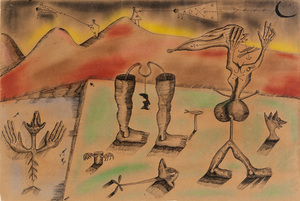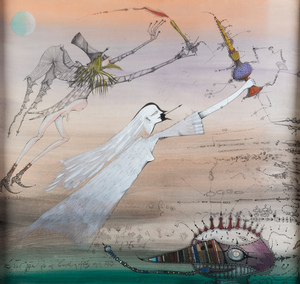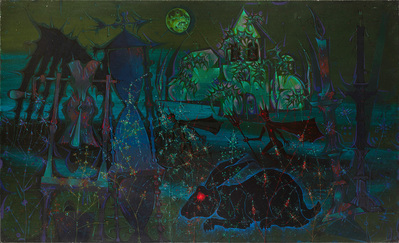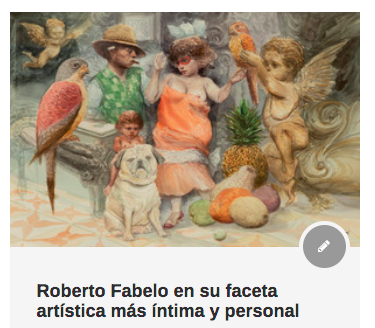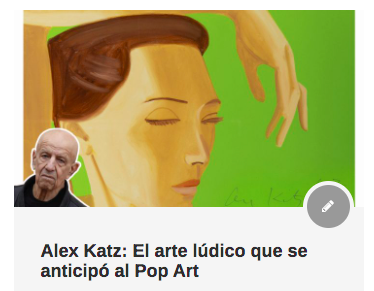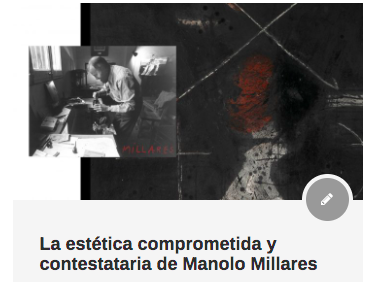The ages of Joan Ponç: from youthful surrealism to the harbingers of maturity
The set of works that we present at the Contemporary Art auction on May 24 highlights the figure of Ponç as one of the most fascinating and enigmatic artists of the second half of the 20th century in Spain.
Art has often been defined as that which is capable of making the invisible visible. An artist who undoubtedly fits this definition like few others is Joan Ponç, brush magician and prowler of hidden kingdoms.
Setdart has brought together in a single auction, works belonging to different vital moments of the artist, which in the case of Ponç takes on special value, because we are dealing with a creator whose spirit and personal experience is reflected (although always in a mysterious way) in his creation. Specifically, drawings and paintings are up for bid that range from his beginnings in the forties (when he ventured into expressionist primitivism, based on self-exploratory portraits) to the eighties, when, in the twilight of his life, he bequeaths us some visions that they almost surpass those of his surrealist stage of Dau Al Set.
At the beginning of the 1940s, Joan Ponç began to forge the complexity of a symbolic language that would crystallize during the creative period of the iconic Dau al Set Group. In a historical context in which the taste for more conventional art dominated, Ponç, together with his groupmates, planted the seed that would drive the renewal of post-war art. In this regeneration, the surrealist heritage that permeated the Spanish artistic environment in the pre-war environment was essential. In this sense, the inspiration provided by the legacy of Joan Miró is especially noteworthy in the work of Ponç, his figure being the one that most effectively embodied the postulates of the Catalan genius. In this way, Ponç searched the human unconscious to give expression to the forms and sensations most deeply rooted in the individual psyche, delving into its most recondite, disturbing and mysterious aspects of its existence. Examples of this are the “Deliri” suite or the gouache “dau al setB-24”, in which there is evidence of a dreamlike world influenced by the powerful symbolism of signs, biomorphic characters, or symbols such as the spiral, the stars or the moon were so typical of the Miró universe. As we can see, his flat drawing, although increasingly sophisticated, focuses on a symbolism that emerges from the organic interrelation of the different elements that make up phantasmagorical and delirious landscapes plagued by unusual creatures whose pure and intense colors are enveloped in an aura dreamy that gives the peculiar telluric aspect that characterized his production.
After the disappointment of the outcome of his experience in Dau al Set, Ponç decides, on the recommendation of Joan Miró, to settle in Brazil where he remained throughout this decade until in 1962 his health problems forced him to return to Catalonia. In the country of Rio de Janeiro, he found the right environment for the development of that oneiric universe that will become more cryptic and hermetic. During this period he will give birth to one of his most emblematic series such as “Caps” as a result of his contact with the blacks of bixiga and his visits to the synagogues of Sao Paolo where, as in a kind of baptism, Lohanan emerges, his new artistic identity. linked to the Hebrew world. The multiple expressions and moods of the 99 harlequin heads (alter ego of the artist) are united by a search for the absolute and sacred that materializes in the verticality and ascension of the conical hat and the half-open mouth like a portal to the divine.
Beginning in the 1960s and once again installed in Catalonia, Ponç will continue to experiment and evolve both on a technical and expressive level. However, his growing health problems will become more and more present in his production, reflecting in it the obsessive anguish towards illness and death, but also the physical pain that as a result of his diabetes he began to feel in each of his limbs. that will now appear in his work scattered in different parts. Despite this, Ponç will continue to display the meticulous detail and precision that characterized his drawing, which, as in this case, weaves under a profuse geometric framework. Likewise, it will be in these years when his technical experimentations will lead him to what he called acupuncture, where thanks to the use of small brushstrokes made by means of a denser solution than usual, he managed to make the paint stand out from the canvas (just as it happens on the canvas). what we will see later ““Pyrenean Night”)
Finally, and as a culmination to this magnificent set that we include in auction, we have the canvas “Pyrenean Night” (1980-1983). Ponç worked on it with meticulous dedication over the course of three years, already affected by diabetes that had left him partially blind. The night, which in a certain way runs through all of Ponç’s creations, now reaches its full meaning: darkness referring to the enigma of life, the mystery of symbols, mysticism, but also now to eternal darkness, to the kingdom of eternal darkness that Ponç feels approaching. We are before a captivating painting, in which a black rabbit with glowing red eyes crosses a field populated by ghosts and demons. A haunted castle can be seen in the distance. The moon bears on its face the silhouette of a bat. Emerald green, cobalt blue, black and red make up the color spectrum of this incursion into the abyss of dreams.
